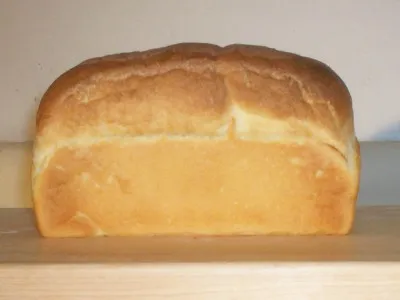
This loaf was made using the "sponge and dough" method that I use for most of my bread. The inclusion of a large amount of kefir (a cultured milk product similar to yogurt, but containing more microorganisms) lends a rich aroma and flavor to the bread. Here is the formula:

After six hours of fermentation at room temperature, the sponge (preferment) is ripe.

The dough ingredients were then used to break up the preferment, after which all ingredients were machined in a 7 cup food processor for 45 seconds. The fully developed dough was then turned out onto a wooden board and rounded.

After a short rest (6 minutes) the dough was moulded and placed in a greased 10" x 5" x 3" oversize loaf pan.

The dough rose quickly to fill the pan:

Right out of the oven:

Finally, a crumb shot:

Bob
I ask because a while ago, I used kefir for my WW loaves and I had extensive dough degradation. If I remember right, I did an overnight cold retard at the time. By the time morning came around, I could pull off clumps of dough that had hairlike strands on the ends. Right before my eyes it would dissolve into a puddle. Needless to say, I have not used kefir since. I experienced this multiple times and never figured out why. I weas using home milled ww flour that successfully made loaves as long as I didn't use kefir. So my kefir is for breakfast but just not in my bread. Any thoughts?
Your loaf is gorgeous and the write-up is so easy to follow. I am curious why you use lecithin? Is it liquid or granules? What does it bring to the table? Is the loaf very different without it?
Kefir has a definite retarding effect on the sponge, probably because of its high acidity. It appears to slow down yeast and enzyme activity. When 56% kefir is included in the sponge, it expands slower than normal, and only rises to 2/3 normal volume.
Honey was included in the preferment (not a normal technique) to compensate for lack of diastatic activity, giving the yeast simple sugars to feed on. The honey, along with a fairly high level of instant yeast (0.8%), made the sponge livelier.
Since kefir exerts a large retarding effect, further retardation through refrigeration could slow down fermentation to a standstill, and may have rheological implications as well. In addition, do not use kefir right out of the refrigerator, but allow it to warm at room temperature for about an hour before adding to the other ingredients (especially yeast). Let the sponge ferment at room temperature (70 - 75° F) for at least 6 hours, or until the sponge hits the "drop".
I have not made kefir bread using whole wheat yet, although I may do so in the near future. Kefir should go well with rye bread, so that will probably be next.
I use lecithin granules, which are widely available at most health food stores (I get mine at GNC). Lecithin is a powerful emulsifier (technically a surfactant), and is the first emulsifier to widely be used in bread baking. It is said to increase fermentation tolerance, improve machinability, and promote a smoother texture and uniform grain. It also imparts a drier "feel" to the dough, allowing easier handling and reduced use of dusting flour. When coupled with shortening, lecithin improves keeping quality.
sandwich loaf Bob. Love the Kifir in it. Well done and
Happy baking